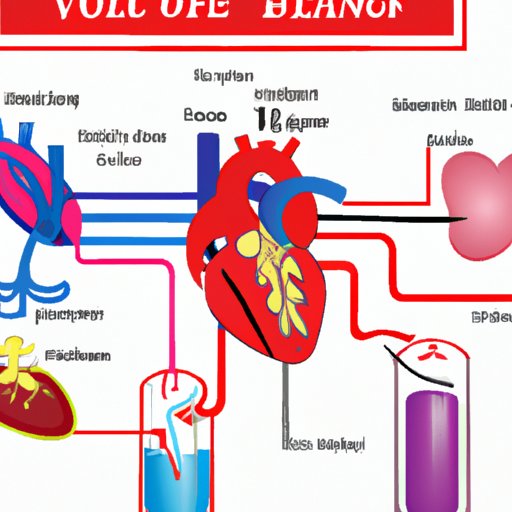Introduction
The cardiovascular system is an intricate network responsible for the delivery of oxygen, nutrients, and hormones to cells throughout the body. The heart plays a crucial role in this process, as it is the organ that pumps blood around the body. In order to understand how the heart functions, it is important to understand how blood moves through it. This article explores the pathways, valves, and chambers that facilitate blood flow through the heart.
Exploring the Pathways of Blood Flow in the Heart
The movement of blood through the heart is known as cardiac circulation. This process begins with deoxygenated blood entering the right atrium from the superior and inferior vena cava veins. From here, the blood passes through the tricuspid valve into the right ventricle, where it is pumped out of the heart via the pulmonary artery.
From the lungs, the now oxygenated blood returns to the left atrium via the pulmonary vein. This blood then passes through the mitral valve into the left ventricle, where it is pumped out of the heart via the aorta. This oxygen-rich blood is then circulated throughout the body, bringing vital oxygen and nutrients to cells and organs.

Understanding the Role of Cardiac Muscle in Blood Flow
Cardiac muscle is an essential part of the cardiovascular system, as it is responsible for the contraction and relaxation of the heart during each beat. This action helps to push blood through the heart and out to the rest of the body. According to a study by the Cleveland Clinic, “The rhythmic contractions and relaxations of the heart are triggered by electrical impulses generated by specialized cells in the sinoatrial node and other areas of the heart.”
The role of oxygen in the process of blood flow through the heart is also significant. As blood enters the right side of the heart, it is low in oxygen. During its passage through the lungs, oxygen is taken up by the blood, before it is returned to the left side of the heart. This oxygen-rich blood is then circulated throughout the body, providing the necessary fuel for cells and organs to function properly.

Comparing and Contrasting Blood Flow Through the Right and Left Sides of the Heart
It is important to note that there are some differences in the way blood flows through the right and left sides of the heart. On the right side, the blood is low in oxygen, whereas on the left side it is oxygen-rich. Additionally, the pressure within the two sides of the heart is different. The right side of the heart has a lower pressure than the left side, which enables the blood to be pushed through the lungs for oxygenation.
Conclusion
In conclusion, the heart is a vital organ that facilitates the circulation of blood throughout the body. Its complex anatomy and physiology enable it to pump blood through the body, while maintaining the correct pressure and oxygen levels. This process involves the movement of blood through the four chambers and three valves of the heart, as well as the contraction and relaxation of cardiac muscle. Understanding how blood moves through the heart can help us to better appreciate the importance of this organ.
(Note: Is this article not meeting your expectations? Do you have knowledge or insights to share? Unlock new opportunities and expand your reach by joining our authors team. Click Registration to join us and share your expertise with our readers.)
